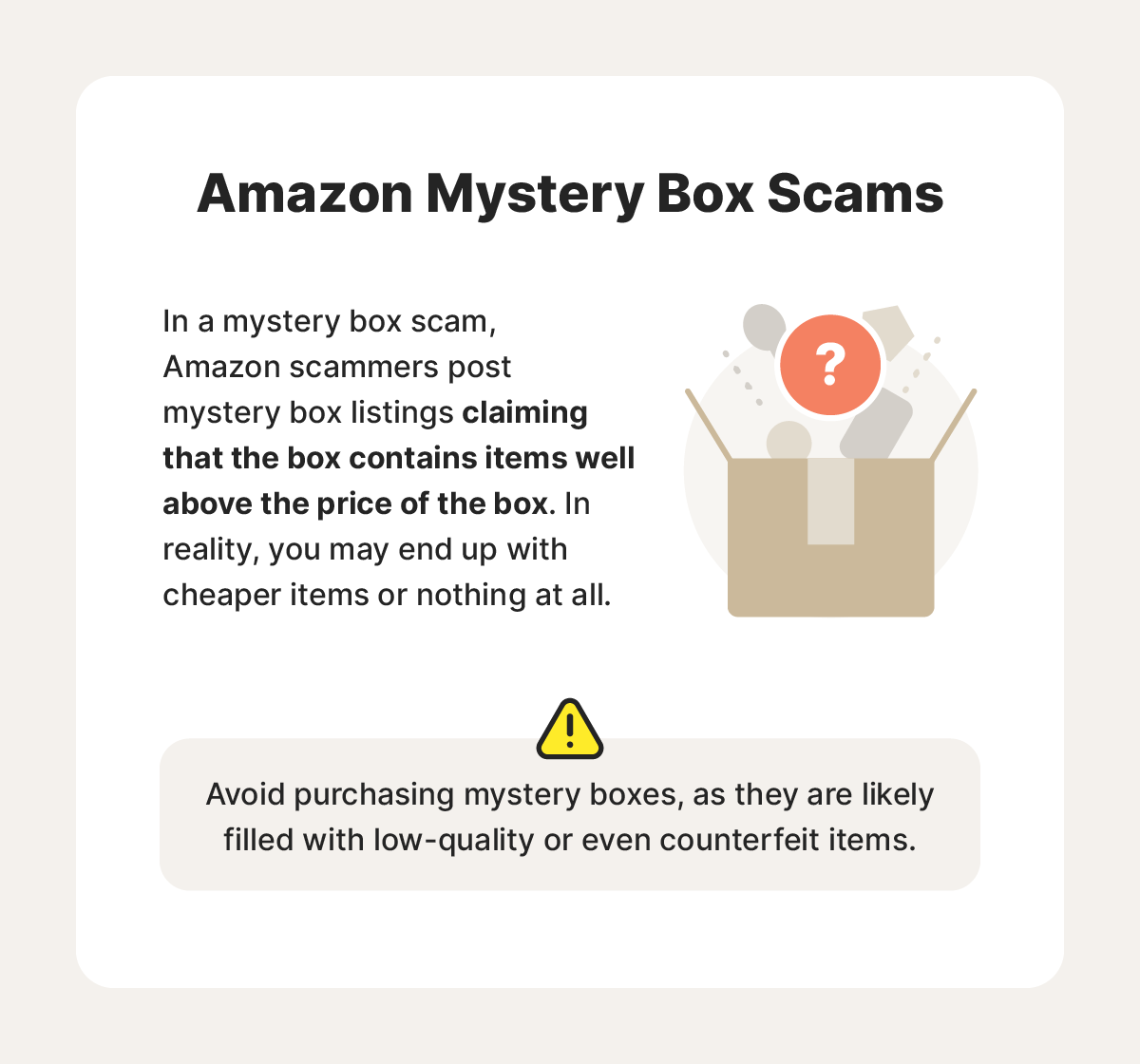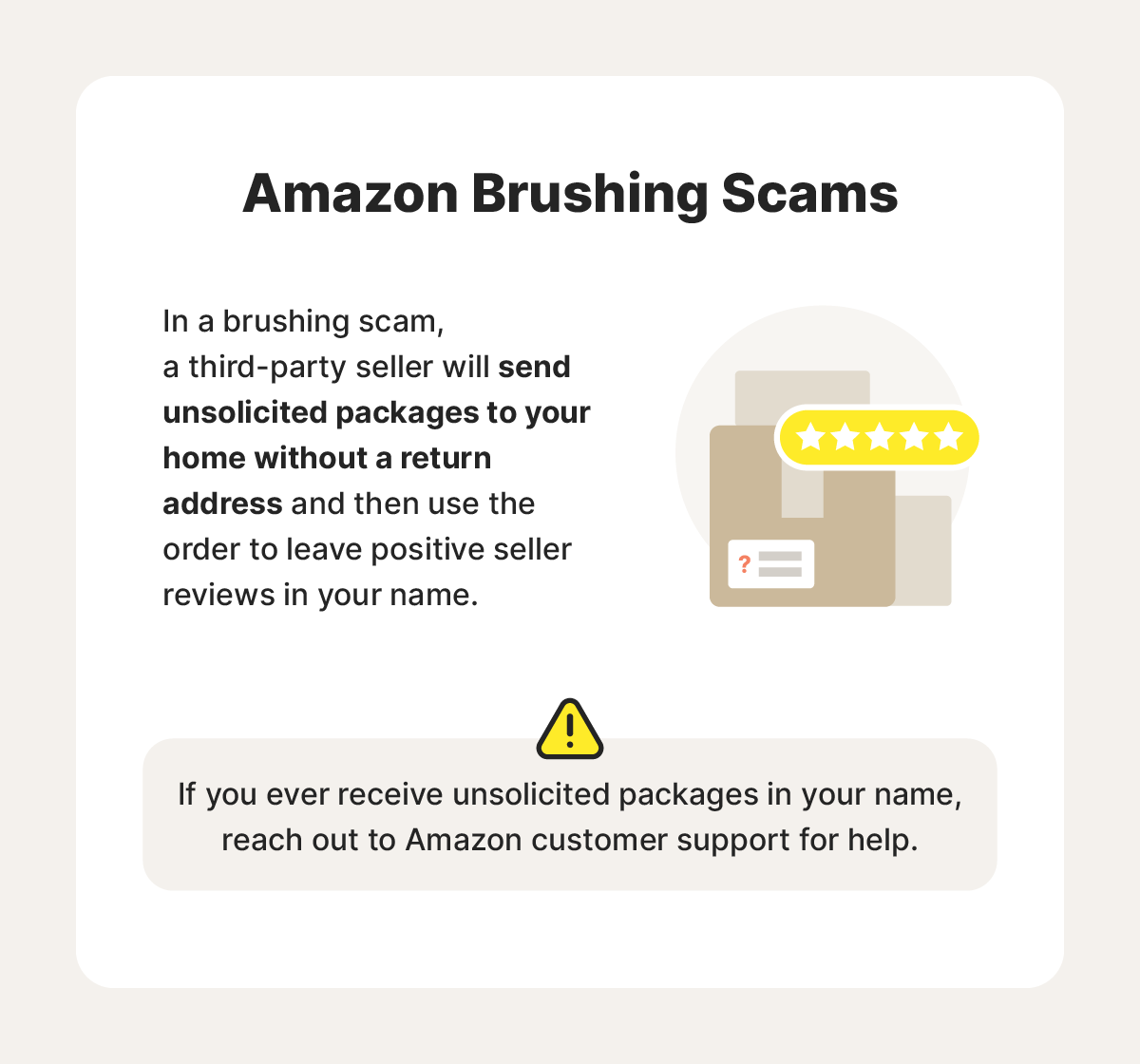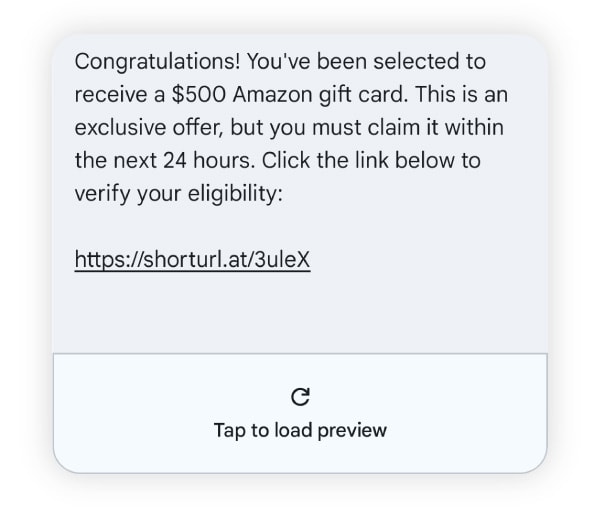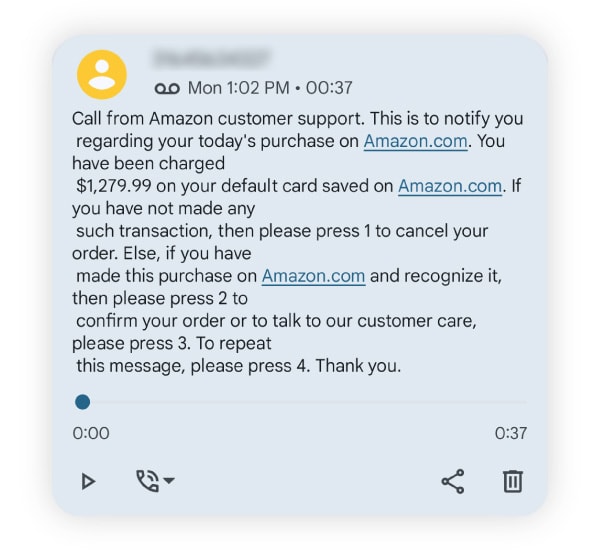The latest Amazon scams fooling online shoppers
Shopping on Amazon is quick and easy — but so is falling for the ploys scammers use to target shoppers. From phishing attacks to fraudulent sellers, scams on Amazon can cost you dearly and put your personal data at risk. Learn how to spot Amazon scams and get Norton 360 Deluxe to help stay safer while you shop online.

Scammers love to impersonate major retailers, and Amazon ranks among the most commonly targeted companies. In fact, 2025 research suggests that Amazon scams account for around 80% of all phishing attacks impersonating major consumer brands.
The situation is so bad, that in the lead up to Black Friday and Cyber Monday 2025, Amazon sent out an alert about scammers trying to get ahold of customers’ “sensitive information like personal or financial information, or Amazon account details.” The FBI has also warned about the threat of account takeover fraud, which has led to more than $262 million in reported losses in 2025 alone.
In 2023, scammers posing as Amazon were able to steal roughly $19 million from unsuspecting shoppers. And scammers operating directly on the platform continue to deceive shoppers with fraudulent schemes.
Familiarize yourself with the most common Amazon scams so you can protect yourself. Let’s Add to Cart safely, shall we?
1. Off-platform payment scams
In an off-platform Amazon payment scam, the scammer aims to trick you into paying them for a fake item outside the Amazon app or website, often on a person-to-person payment app that may not offer buyer protection.
If you follow the scammer’s instructions, your payment will no longer be covered by Amazon’s A-to-z Guarantee policy, preventing you from getting a refund. Even worse, these scammy sellers may send you links to malicious websites that steal your personal information.
This tactic isn’t limited to Amazon — you may also encounter it on other online marketplace platforms as part of Mercari scams or Poshmark scams, for example.
2. Mystery boxes
Mystery boxes are listings that promise a surprise assortment of items — like collectibles or clothing — often at a steep discount. While the idea of receiving a “surprise” may seem fun and exciting, many of these boxes are scams.
Scammers use vague descriptions and fake or misleading reviews to make their listings look legitimate. In reality, these too-good-to-be-true deals are often just that — leaving you with cheaper and lower-quality items than you were led to expect.


3. Phishing emails
Scammers launch phishing attacks to get access to sensitive information. For example, they might send fake messages posing as a customer support representative from Amazon and request that you click a link to verify a product order.
While there are many variations to Amazon phishing scams, they generally all aim to trick you into opening a suspicious link or downloading a malicious attachment. If you don’t catch the phishing attack, scammers may be able to steal your Amazon login credentials or install malware on your device.
Phishing attacks can even lead to full account takeovers. If a scammer gains access to your Amazon account, they could change your email address and password, locking you out. They can then make purchases using your saved payment details or buy gift cards to send to themselves. If you don’t catch it quickly, this can lead to major financial losses.
4. Vishing
Amazon scammers use a tactic known as vishing, or voice phishing, to call users by phone and attempt to steal personal information or payment details.
The scammer may claim to be affiliated with Amazon and pose as a tech support representative or delivery driver. No matter who claims to be on the other end of the line, remain cautious and avoid giving up any sensitive information over the phone, as it could be a scam.
5. Smishing
Smishing is another phishing variant that targets users through SMS (aka text messages). In this scam, fraudsters send text messages pretending to be from Amazon, attempting to trick you into providing payment or personal information.
No matter how convincing a text message may be, avoid responding or engaging with the message at all. Instead, review your account on the Amazon website or app to see if any issues need to be addressed.
6. Fake refund scams
To pull off a fake refund scam, a scammer will impersonate Amazon and reach out to you claiming there’s an issue with a recent order and that you’re eligible for a refund. The catch is that to receive your refund, you’ll either have to follow a link to another website or provide them with personal information.
One Reddit user reported receiving a refund text, but when they checked their Amazon account, they found no record of it, tipping them off that it was likely a scam.
Since these scams rely on tricking users into following instructions or navigating to an unsafe site, it’s best to avoid clicking any links or sharing any information. Instead, contact Amazon directly if you believe a refund is needed.
7. Amazon Prime Video scams
Amazon’s streaming service Prime Video has become a target for scammers who impersonate it for their benefit.
Amazon Prime Video scams typically involve fraudsters creating malicious websites and advertisements targeting keywords such as “how to set up Prime Video on TV.” These sites and ads are designed to imitate Prime Video’s official website but instead include fake instructions that trick you into exposing your Amazon login credentials.
No matter how realistic the website looks, never follow instructions from a third party when setting up or making changes to your Prime Video account. Instead, follow the instructions listed on Amazon’s official website.
Likewise, fraudsters have been sending out fake Amazon Prime Video renewal notices containing forged receipts for fabricated charges. Recipients are encouraged to either open a virus-laden PDF, sign in to a fake login page that captures their Amazon credentials, or call a number connecting them to a scammer.
8. Typosquatting scams
Typosquatting is a tactic in which scammers create a fake website with a URL similar to the site they’re trying to impersonate (Amozan.com, for example). The ultimate goal of this scam is to make Amazon customers believe they are on the official Amazon website and enter their payment information as usual.
If you fall for this scam, you may accidentally give your payment details directly to a scammer who’ll use them to steal your money or commit identity theft.
9. Fake jobs
Amazon scammers target job seekers by posing as Amazon recruiters and creating fake job postings. They often promise high-paying, work-from-home opportunities that are designed to steal personal information or trick job seekers into paying upfront fees.
To avoid falling for these scams, only apply for jobs through Amazon’s official careers page.
10. Amazon gift card scams
In an Amazon gift card scam, scammers will contact you via an Amazon phishing email, text, or phone call with the aim of getting you to buy gift cards for them.
Here’s how it typically goes:
- The scammer will pretend to be from Amazon and inform you that something is wrong with your account.
- The scammer will tell you that you must purchase Amazon gift cards and share the gift card information to resolve the issue.
- Once you follow the scammer’s instructions, they will write down the gift card information and cease all communication with you.
11. Porch pirate scam
A “porch pirate” is someone who steals packages from other people’s homes. But in some cases, a thief nabbing a parcel from your doorstep is only the tip of the iceberg. In a porch pirate scam, a scammer gains access to your Amazon account and orders items to your house for them to intercept.
Scammers carry out this scam in the hopes that you won’t be home when the package is delivered, allowing them to steal the packages without a trace. By ordering the packages to your home address, they can place orders with your saved payment information without giving up their physical address — and avoiding any additional authentication that adding a new address requires.
12. Brushing scams
Imagine opening your front door only to find Amazon packages you never ordered. This has happened to thousands of people the world over, including this TikTok user. While this may come as a pleasant surprise, it’s probably a brushing scam, where third-party sellers send unsolicited packages to your home without a return address.
Scammers do this so they can use the fake orders to write product reviews under your name, allowing them to falsify their seller ratings and attract new customers. And because the seller has your name and address, they may also use your personal information to carry out other scams.


13. Fake invoices
A fake invoice scam involves a scammer sending you a fake confirmation message about a recent Amazon purchase you didn’t make. For example, the invoice may claim that you recently purchased a MacBook Pro for $1,999, and prompt you to click a link to “undo” the order.
Clicking the link could infect your device with malware or direct you to a spoofed site where you’ll be prompted to enter your account information, which the scammer can then use to take over your account and make fraudulent purchases.
14. Counterfeit listings
Scammers use many methods to try to bypass Amazon’s safeguards and sell counterfeit or low-quality goods.
They may hijack legitimate Amazon listings, altering the title, images, and description while keeping real user reviews to appear trustworthy. They often advertise steep discounts on popular products, like a high-end Bluetooth speaker at half price, to lure buyers. Buyers may receive a counterfeit or defective product or nothing at all.
Amazon has implemented several measures to combat counterfeit products, including building prevention tools like the Transparency program, which uses unique codes to verify the authenticity of products. Additionally, Amazon has a global Counterfeit Crimes Unit (CCU) dedicated to investigating and prosecuting counterfeiters.
Despite these efforts, anti-counterfeit measures can’t catch everything. One Reddit user shared their experience of purchasing a heavily discounted item from a third-party seller, only for the seller’s account to be disabled shortly after. When they contacted Amazon for a refund, they were told they had to wait until after the delivery date had passed — leaving them stuck for six weeks before receiving their money back.
15. Amazon “write a review” scams
Amazon review scams typically begin with a phishing email offering you money or gift cards in exchange for reviewing Amazon products. The catch? Once you follow the link, you’ll end up on a fraudulent site designed to trick you into giving up your personal information and payment details.
16. Fake giveaways
If you come across an online Amazon giveaway or prize offer, there’s a good chance it’s a scam. Fraudsters create fake websites promoting giveaways that require you to complete a survey to participate. Some even ask for payment details to cover “shipping costs” for your free item.
If an offer sounds too good to be true, it probably is. Falling for these scams could expose your device to different types of malware or put your personal information at risk of being used in identity theft.


17. Overpayment scams
If you receive an email claiming to be from Amazon stating that you’ve overpaid for an item and need to follow a link or provide personal information to get a refund, it’s likely a scam. Similar to fake refund scams, overpayment scams promise to return a portion of your money after claiming you’ve paid too much.
Whether the email directs you to a link or tells you to call a provided phone number to fix the issue, don’t follow the instructions. The link could take you to an unsafe site, and contacting the scammer could lead them to use social engineering tactics to get you to give up your personal information.
18. Unclaimed package scams
In an unclaimed package scam, scammers advertise unclaimed Amazon packages for sale on social media or other online marketplaces. Depending on the specific listing, the ads may or may not specify what you can expect to find in these packages.
Some ads claim to have specific products while others may say the packages are worth hundreds of dollars. Either way, the ads will claim you’re getting an amazing deal. Whether you end up with less valuable items than you were promised or receive nothing at all, it’s best to avoid purchasing unclaimed Amazon packages, as it’s most likely a scam.
19. Amazon Alexa scams
Alexa, Amazon’s cloud-based voice assistant, isn’t immune to scams. Reports have shown that scammers manipulate Alexa search results to direct users to fraudulent phone numbers instead of legitimate ones. For example, asking Alexa to call Amazon customer support may unknowingly connect you to a scammer.
Amazon works hard to correct security issues like these, but to stay safe, always verify phone numbers before making a call — don’t rely solely on Alexa to find customer service contacts.
20. Customer service impersonation
Many scammers impersonate Amazon customer service representatives to trick users into revealing sensitive information. Amazon has reported a 33% increase in these scams since December 2024.
Here’s how it typically works:
- The scammer monitors customer complaints on social media.
- They then respond to these posts using fake accounts pretending to be Amazon customer service.
- The scammer tries to redirect customers to click on suspicious external links or asks for personal information, such as your email address, password, or other account details, to “resolve” the issue.
These scams can be highly convincing, as fraudsters often create fake accounts with usernames and logos that closely resemble official Amazon pages. They also post fake customer service numbers that appear in search results, tricking users into calling them. In one case, a woman dialed what she believed was Amazon’s official support line — only to be scammed out of her life savings by a fraudster posing as a representative.
To protect yourself, only communicate through Amazon.com, the official Amazon app, or verified Amazon social media accounts.


21. Fake Amazon advertisements
In malvertising attacks, scammers use fake ads on social media, search engines, and other websites to impersonate Amazon deals. Investigations by Reuters suggest that ads for scams on social media are surprisingly prevalent, with Meta platforms possibly showing users 15 billion scam ads a day. With 44% of people making purchases based on social media ads, this is a major problem.
These scam ads typically promise steep discounts or “limited-time Amazon deals,” but once clicked, they redirect you to counterfeit storefronts that either steal your payment details, account credentials, or install malware on your computer.
Thanks to advances in AI, these storefronts look and feel shockingly realistic, leading scam researchers at Gen, Norton’s parent company, to label them “VibeScams.”
How to avoid Amazon scams
To protect yourself from Amazon scams, stay alert to warning signs and follow these cybersecurity tips for a safer shopping experience:
- Only use official Amazon channels: Download the official Amazon app or bookmark Amazon’s official website to avoid accidentally navigating to fake copies of the website.
- Don’t click suspicious links: Whether it’s included in an email or text message, avoid clicking links and attachments from unknown senders. They could send you to an unsafe site or expose your device to malware.
- Ignore unverified messages: Avoid all communications from untrusted, unverified sources. If something truly needs to be addressed regarding your Amazon account, you’ll be informed when you log in to the website or app.
- Protect your sensitive data: Scammers often seek personal information to steal your identity or commit fraud. Avoid sharing your address, payment details, or other information unless you’re sure you’re on a legitimate Amazon page. Never share your Social Security number.
- Enable 2FA: Setting up 2FA adds a layer of protection between a scammer and your Amazon account, which can help prevent unauthorized access.
- Update your password: Changing your password periodically can help keep Amazon scammers from hacking your account.
- Install antivirus software: Protect your device with antivirus software, like Norton 360 Deluxe, to reduce the risk of malware infection if you fall victim to a scam.
What to do if you get scammed on Amazon
If you’ve fallen victim to an Amazon scam, take the following steps based on what happened to minimize potential damage and help protect against further fraud:
If you got scammed by an Amazon seller:
- Cease all communication with the seller.
- Report the incident to Amazon.
- File a police report if the scam took place outside of Amazon.
- Dispute any charges with your credit card company.
If you disclosed sensitive information:
- File a report at IdentityTheft.gov.
- Change all passwords to new, secure ones.
- Use a dark web monitoring service to check if your personal info is on the dark web.
If you lost money:
- Inform your payment provider (bank, credit card company, etc.) of the fraudulent transaction.
- Follow their instructions to reverse the transaction.
- Monitor your accounts for any additional unauthorized transactions.
If an unauthorized person accessed your Amazon account:
- Change your password immediately.
- Monitor your saved payment methods for unauthorized transactions.
- Check your account information to ensure the hacker hasn’t changed the phone number and email address associated with your account.
- Check your gift card balance to see if funds have been stolen.
- Check your order history for fraudulent purchases.
- Inform Amazon of the security breach at (888) 280-4331 or fill out the Report Unauthorized Activity form.
Finally, don’t forget to report fraud to Amazon:
- Log in to your Amazon account on the mobile app or official website.
- Visit the official customer service page.
- Scroll down and select Security & Privacy from the left-hand menu.
- Click Report Something Suspicious.
- Follow Amazon’s instructions to report Amazon scams.
Whenever you report a scam, be sure to provide as many details as possible. This will increase the chances of the scammer getting caught and help prevent them from scamming other innocent Amazon customers in the future.
Stay secure while you shop with Norton
Now that you know how to spot Amazon scams and phishing tricks, take your online security to the next level.
While some scams are easy to recognize, many are designed to fool even the savviest shoppers. Norton 360 Deluxe uses advanced AI-powered scam detection to help you spot suspicious texts, websites, and links before they trick you. And that’s just the beginning. You’ll also get a VPN, dark web monitoring, and powerful, always-on protection against hackers, viruses, and malware.
FAQs
Can you get scammed on Amazon Prime?
Yes, Amazon scams can affect all Amazon customers, whether you’re an Amazon Prime member or not.
Does Amazon call you to verify purchases?
In some rare cases, Amazon may call customers to confirm purchases if they detect suspicious activity. However, they will never ask for sensitive information, such as passwords or payment details, or offer unexpected refunds.
Is Amazon safe?
Generally speaking, yes, Amazon is safe to use. With that said, it’s important to always practice caution and follow your best judgment when using the site, as there are shady sellers on Amazon that target unsuspecting customers.
How does Amazon handle scams?
Amazon has several measures in place to handle scams on its platform, including machine learning to identify potential fraud, educational resources to help customers spot scams, and a dedicated reporting channel, reportascam@amazon.com.
What Amazon scams are going around?
Impersonation scams are currently one of the most common types of Amazon scam happening today. Fraudsters pose as Amazon customer service representatives or delivery drivers to steal your personal information or money.
Amazon is a trademark of Amazon, Inc.
Editorial note: Our articles provide educational information for you. Our offerings may not cover or protect against every type of crime, fraud, or threat we write about. Our goal is to increase awareness about Cyber Safety. Please review complete Terms during enrollment or setup. Remember that no one can prevent all identity theft or cybercrime, and that LifeLock does not monitor all transactions at all businesses. The Norton and LifeLock brands are part of Gen Digital Inc.








Want more?
Follow us for all the latest news, tips, and updates.